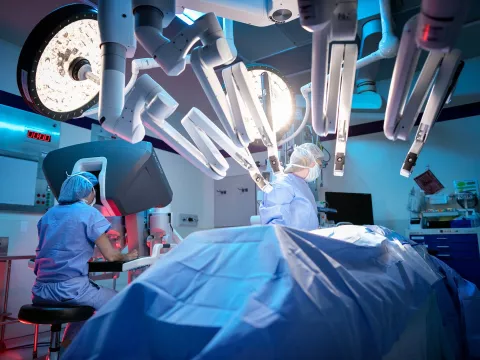- AdventHealth

Choose the health content that’s right for you, and get it delivered right in your inbox.
Technological advances in health care continue to push the limits of what we can accomplish in providing the best possible care for patients and their overall wellbeing. Robotic surgery has been an option for surgeons for many years, but technology is more sophisticated than ever in treating conditions affecting the heart, digestive system, bladder, colon, lung, prostate and more in a less-invasive way.
As one of the most advanced robots in use, the da Vinci® Xi surgical system is a viable alternative to open surgery and laparoscopic procedures for many patients. “The da Vinci robot has revolutionized surgery,” said Dr. Edwin Menor, AdventHealth Surgeon of Excellence in Robotic Surgery. “And it has been proven to be highly beneficial to both surgeons and patients alike.”
Robotic surgery uses small incisions
Traditional open surgery requires incisions up to several inches long, depending on the type of procedure. Incisions for robotic procedures can be much smaller.
Working through very small incisions, a surgeon controls the delicate mechanical hands of the robot throughout the entire procedure. Smaller incisions offer numerous benefits for patients, from less blood loss and a lower risk of infection to faster healing and smaller scars.
Robotic techniques enhance surgical precision
Robotic surgery is a little bit of a misnomer. It may conjure up futuristic images of robots performing surgery. Today’s medical “robots” are really tools used by the surgeon to improve precision and provide a clear visualization of the surgical area. Highly sophisticated cameras provide magnified, high-definition views of the surgical area with 3D capabilities that are superior to the naked eye.
The robotic arm’s movements are controlled by the surgeon, are more exact than a human hand and have a greater range of motion. The small instruments attached to the robotic system also allow surgeons to perform steps of the operation inside a patient’s body when traditionally, they would have had to make a much larger incision to do that part of the procedure outside of the body.
Robotic surgery offers faster recovery times
One of the biggest benefits of robotic surgery is that it can shorten recovery time. Smaller incisions and less trauma to the body mean that patients generally have less pain compared to traditional surgery. “Patients appreciate that they are back at home and back to work more quickly than in years past,” said Dr. Menor.
Patients can expect to have less bruising, less swelling, and a lower risk of complications in recovery. In fact, many robotic surgery patients go home after just a night or two in the hospital. In some cases, patients may be able to go home the same day as the surgery.
Recovery time varies depending on your health and the type of surgery, but you can expect to return to your usual daily activities within a few days or weeks.
Overall, robotic systems are a tool for surgeons to improve patient care and recovery time. It is important to work with a physician to develop a customized treatment plan that is best for you.
To learn more about the latest innovations and technologies available at AdventHealth, including robotic-assisted surgery, visit YourCareExperts.com.




